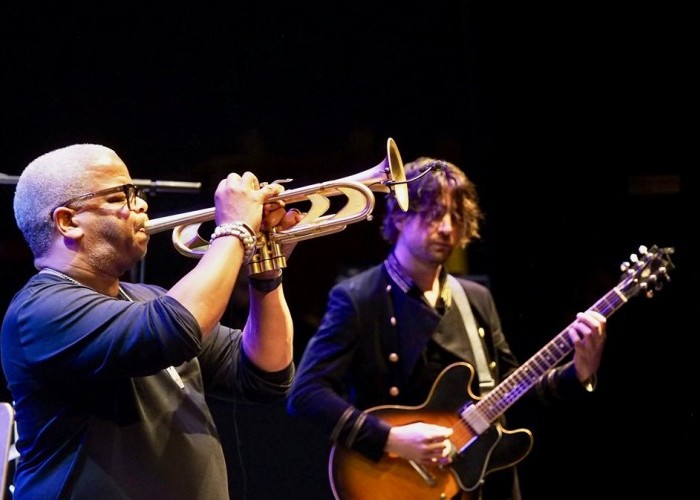Apr 2, 2024 12:59 PM
Saxophonist, Sonic Explorer Casey Benjamin Dies at 45
Casey Benjamin, the alto saxophonist, vocalist, keyboardist and producer who stamped his distinctive sounds on the…

Terence Blanchard performs with his E-Collective ensemble during the Umbria Jazz Festival, which ran July 11–21 in Perugia, Italy.
(Photo: Courtesy Umbria Jazz)During the 43rd Umbria Jazz Festival, which ran July 11–21 in Perugia, Italy, crowds gathered in the streets for free shows, absorbed the music at ticketed concerts and crammed into small clubs for after-hours jam sessions.
Each year, instead of being flooded with music from outside Italy, Umbria has served as a showcase for the country’s top talent. And for this edition of the festival, the 785-seat Teatro Morlacchi hosted renowned trumpeter Paolo Fresu’s sublime performance of work from 2018’s Summerwind (ACT) alongside Swedish bassist Lars Danielsson; drummer Roberto Gatto’s dynamic quartet of rising stars; and pianist Danilo Rea accompanying Gino Paoli in an orchestral celebration of the famed singer-songwriter’s 60-year career.
Italian artists frequently commanded center stage: Clarinetist Gianluigi Trovesi joined in a playful duo with accordionist Gianni Coscia in the Jazz Goes to the Museum series in the newly configured Sala Podiani at La Galleria Nazionale dell’Umbria. The pair delivered a set of tonal beauty, surprising harmonies and conversational contrapuntal lines in low-register-to-high-trill melodies teeming with a wink-eye whimsy in the mix. Their soulful—and at times shrieking—versions of Italian folk tunes made for an unpredictable marvel. But the highlight of the show came midway through with Trovesi’s idiosyncratic tune “Hercab,” a song off his 1992 album, From G To G.
Back at the Morlacchi the night before the festival ended, flugelhornist Enrico Rava revved up his Special Edition sextet in celebration of his 80th birthday. With his long, flowing gray hair to his shoulders, Rava played young as he collaborated with his band of protégés in rocking, oblique, churning zones on originals, such as “The Fearless Five” and “Lavori Casalinghi.”
Rava opened the songs up for select solos by his ensemble, spotlighting young pianist Giovanni Guidi, who exhibited a special connection as instigator and foil with the bandleader. Rava’s show concluded with glee on his festive run through “Quizás, Quizás, Quizás,” the standard composed by Osvaldo Farrés.
The auditorium San Fresco Al Prato reopened after decades of renovation to host keyboardist/composer Uri Caine’s captivating commissioned tour de force, the seven-movement Seven Dreams with his tight rhythm section—bassist Mark Helias and drummer Clarence Penn—and the strings and reeds of the Umbria Jazz Orchestra and Orchestra Da Camera Di Perugia.
But the rock element—a commercial necessity for many fests—filled the outdoor 15,000-seat Arena Santa Giuliana on most nights. This contingent included blues rock guitarist Robben Ford, plus a thrilling set by prog-rock band King Crimson, celebrating its 50th anniversary, led by the legendary Robert Fripp.
The venue also featured a hefty dose of top-notch American jazz. Highlights included charismatic vocalist/bandleader Allan Harris, who won over the crowd with his Nat “King” Cole show, and pianist/singer Diana Krall diving deep into improvisational territory with bassist Robert Hurst and drummer Karriem Riggins, augmented by brilliant soloists Joe Lovano on saxophone and Marc Ribot on guitar.
It was a new Krall. Even her swinging, imaginative retelling of Cole Porter’s “I’ve Got You Under My Skin” transcended her early-career renditions in a setting similar to Joni Mitchell’s 1980 Shadows And Light live concert band, a troupe that included saxophonist Michael Brecker and guitarist Pat Metheny.
Three nights later, Chick Corea and the Spanish Heart Band opened with a Latin-charged run through a Stravinsky piece, surprised the crowd with flamenco tap dancer Nino de los Reyes, paid homage to guitarist Paco de Lucía (1947–2014) and ended the show with “Spain,” with the bandleader playfully engaging the sold-out crowd in a call-and-response of the song’s classic theme.
At Teatro Morlacchi, Terence Blanchard and his band, the E-Collective, continued to push jazz into the future with exhilaration-meets-danger electronics.
And in one of the best shows of the festival, a smiling and happy Charles Lloyd cheered on his new double-guitar ensemble with two of the genre’s best six-stringers: the renowned Julian Lage and the underappreciated Marvin Sewell. The saxophonist/bandleader called the show “Kindred Spirits,” and that it was. DB

Benjamin possessed a fluid, round sound on the alto saxophone, and he was often most recognizable by the layers of electronic effects that he put onto the instrument.
Apr 2, 2024 12:59 PM
Casey Benjamin, the alto saxophonist, vocalist, keyboardist and producer who stamped his distinctive sounds on the…

“He’s constructing intelligent musical sentences that connect seamlessly, which is the most important part of linear playing,” Charles McPherson said of alto saxophonist Sonny Red.
Feb 27, 2024 1:40 PM
“I might not have felt this way 30 to 40 years ago, but I’ve reached a point where I can hear value in what people…

Albert “Tootie” Heath (1935–2024) followed in the tradition of drummer Kenny Clarke, his idol.
Apr 5, 2024 10:28 AM
Albert “Tootie” Heath, a drummer of impeccable taste and time who was the youngest of three jazz-legend brothers…

“Both of us are quite grounded in the craft, the tradition and the harmonic sense,” Rosenwinkel said of his experience playing with Allen. “Yet I felt we shared something mystical as well.”
Mar 12, 2024 11:42 AM
“There are a few musicians you hear where, as somebody once said, the molecules in the room change. Geri was one of…

Larry Goldings’ versatility keeps him in high demand as a leader, collaborator and sideman.
Feb 21, 2024 10:45 AM
Are you having any fun? Larry Goldings certainly is. Consider just two recent examples:
Scene 1: “If anyone had…